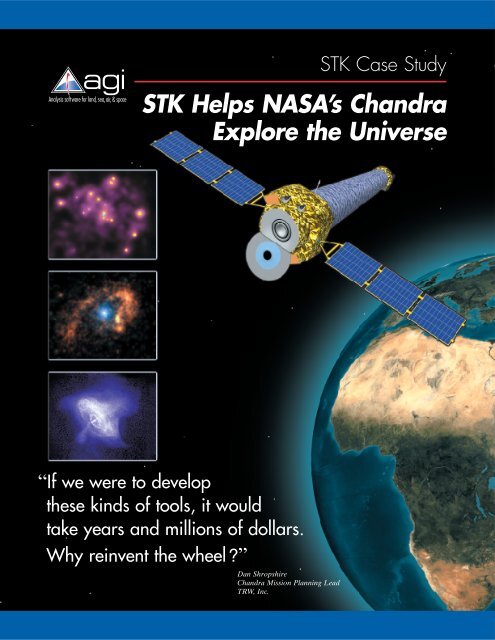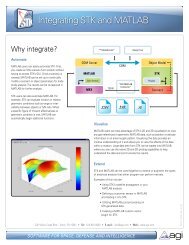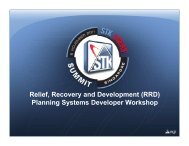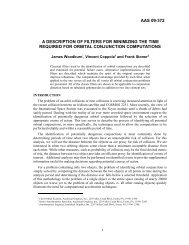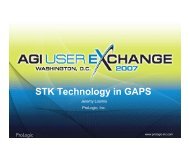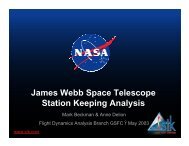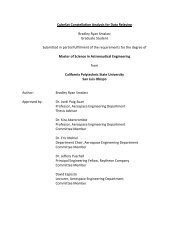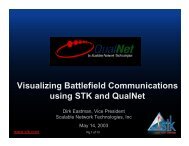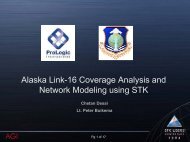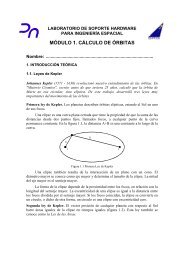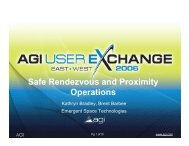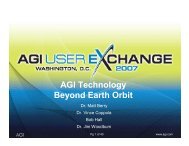STK Helps NASA's Chandra Explore the Universe - AGI
STK Helps NASA's Chandra Explore the Universe - AGI
STK Helps NASA's Chandra Explore the Universe - AGI
You also want an ePaper? Increase the reach of your titles
YUMPU automatically turns print PDFs into web optimized ePapers that Google loves.
<strong>STK</strong> Case Study<strong>STK</strong> <strong>Helps</strong> NASA’s <strong>Chandra</strong><strong>Explore</strong> <strong>the</strong> <strong>Universe</strong>“If we were to develop<strong>the</strong>se kinds of tools, it wouldtake years and millions of dollars.Why reinvent <strong>the</strong> wheel?”Dan Shropshire<strong>Chandra</strong> Mission Planning LeadTRW, Inc.
<strong>Chandra</strong> ObservatoryDetects Sources 20 TimesFainter Than Any PreviousX-ray Telescope‘‘We could see and determineso many things with <strong>STK</strong>that we couldn’t conceptualizewith just <strong>the</strong> numbers.”Dan Shropshire<strong>Chandra</strong> Mission Planning LeadTRW1 100 10,000 10 million 10 billiondegree K degrees K degrees K degrees K degrees KRadio Microwave Infrared Visible UV X-raysLightGammaRays0.5 50 0.5 1 0.0005centimeters microns microns nanometer nanometerWAVELENGTHNote: degrees Kelvin (K) = degress Celsius (C) + 273X-rays are created by temperatures at millions of degrees Celsiusas shown in <strong>the</strong> above electromagnetic spectrum.The images are spectacular: a glowing cosmiccrossbow; a cool-green galaxy caught cannibalizingano<strong>the</strong>r; and an iridescent purple mushroomcloud shrouding <strong>the</strong> heart of a rapidlyspinning neutron star.Photographs like <strong>the</strong>se have been inspiring astronomers since<strong>the</strong> launch of NASA’s <strong>Chandra</strong> X-ray Observatory in July1999. Capturing rays that can’t be seen on Earth by <strong>the</strong> humaneye or conventional optical telescopes, this space-basedobservatory has provided conclusive proof of some long-heldscientific <strong>the</strong>ories, given insight into <strong>the</strong> evolution of galaxies,and forced astronomers to take a new look at <strong>the</strong> universe.<strong>Chandra</strong> joins NASA’s past and present family of Earthorbitingobservatories, including <strong>the</strong> Hubble SpaceTelescope and <strong>the</strong> Compton Gamma Ray Observatory. Ithouses <strong>the</strong> world’s premier X-ray telescope, which recordsdistant images eight times sharper and detects X-raysources 20 times fainter than any X-ray telescope before it.According to NASA scientists, its resolving power—0.5arc-seconds—would be equivalent to a person reading astop sign from 12 miles away or comprehending anaverage-sized newspaper headline from a distance of a halfmile. Capturing <strong>the</strong>se images is a special high-resolution,cylindrical mirror assembly that houses <strong>the</strong> largest andsmoo<strong>the</strong>st mirrors of <strong>the</strong>ir kind ever created. IncomingX-rays, which would penetrate normal mirrors, graze offtwo sets of four nested mirrors and are channeled into aninstrument section for detection and study. The largest of<strong>the</strong> eight is almost 4' in diameter and 3' long. Toge<strong>the</strong>r, <strong>the</strong>mirror group weighs more than a ton.Managed by NASA’s Marshall Space Flight Center inHuntsville, AL, <strong>Chandra</strong> is one of <strong>the</strong> largest and heaviestpayloads <strong>the</strong> Space Shuttle has launched. The Harvard-Smithsonian Astrophysical Observatory’s <strong>Chandra</strong> X-rayCenter (CXC) in Cambridge, MA, manages <strong>the</strong> <strong>Chandra</strong>www.stk.com
Aspect camera stray light shadeSunshade DoorSpacecraft ModuleSolar Array (2)Optical BenchHigh ResolutionMirror Assembly(HRMA)Thrusters (4)Low Gain Antenna (2)TransmissionGratings (2)CCD Imaging Spectrometer (ACIS)High resolutioncamera (HRC)IntegratedScienceInstrumentModule(ISIM)The <strong>Chandra</strong> X-ray Observatory has three basicassemblies: <strong>the</strong> spacecraft, telescope, and <strong>the</strong>science instrument panels.An <strong>STK</strong> two-dimensional map traces <strong>Chandra</strong>’s groundtrack as it moves in its orbit.<strong>Chandra</strong> captured this imageof <strong>the</strong> compact nebula around<strong>the</strong> neutron star Vela Pulsar.NASA’s most powerful X-ray telescope circles <strong>the</strong> globe in a highly ellipticalorbit, ga<strong>the</strong>ring images of <strong>the</strong> universe and sending <strong>the</strong>m back to Earth.science program and controls <strong>the</strong> observatory for NASA.TRW Space and Electronics Group of Redondo Beach,CA, leads <strong>the</strong> contractor team that built <strong>Chandra</strong> and managesflight operations in Cambridge.According to industry experts, <strong>Chandra</strong> has opened a newwindow for astronomers into <strong>the</strong> universe of high-energycosmic events such as pulsars, supernova remnants, andblack holes. Scientists are now able to create spectacularlydetailed images of celestial phenomena whose mere existence<strong>the</strong>y could only hypo<strong>the</strong>size before.<strong>STK</strong>’s Role in <strong>the</strong> MissionSatellite Tool Kit® (<strong>STK</strong>) was used extensively during <strong>the</strong>mission’s design and development stage and played a crucialrole in transfer-orbit operations. “We are extremely pleasedwith <strong>the</strong> level of involvement that <strong>STK</strong> has had with such aprestigious mission,” says Joe Murphy, <strong>STK</strong> product managerat Analytical Graphics, Inc. (<strong>AGI</strong>). “This telescope willhelp scientists probe even deeper into <strong>the</strong> mysteries of space.The fact that <strong>the</strong> <strong>Chandra</strong> team chose <strong>STK</strong> for so manyaspects of this historic mission shows <strong>the</strong> versatility andtrusted precision of <strong>the</strong> software.”TRW’s Mission Planning group maps out all of <strong>Chandra</strong>’sobservations, working directly with <strong>the</strong> science communityto schedule a list of observations, build <strong>the</strong> commandloads for <strong>the</strong> observation sets, and hand those off to <strong>the</strong>controllers for uplink. The group also handles <strong>the</strong> flightdynamics portion of <strong>the</strong> work, which includes calculatingall <strong>the</strong> orbital elements, plots of access times to <strong>the</strong> groundstations, eclipse times, and all attitude determination. “Weused <strong>STK</strong> to predict start and stop times of eclipses basedon <strong>the</strong> position of <strong>the</strong> spacecraft and compared those timesto when <strong>the</strong> coarse sun sensor current output declined,”says TRW mission planning lead Dan Shropshire.<strong>STK</strong>/PRO® and <strong>STK</strong>/Advanced VO were integrated aspart of <strong>the</strong> original ground system to do real-time visualization.The <strong>STK</strong> software suite was later expanded with<strong>the</strong> addition of o<strong>the</strong>r modules, including <strong>STK</strong>/Astrogator®and <strong>STK</strong>/Comm. <strong>STK</strong>/Advanced VO provides 3-Dwww.stk.com
epresentation of <strong>the</strong> satellite and surrounding environment,including real-time dynamic display of satelliteposition and altitude display for operations. <strong>STK</strong>/Commperforms communications analysis such as link margins tocompare real-time performance with predicted values.<strong>STK</strong>/PRO is also used to calculate many different types ofmission data, including ground-station visibility andeclipse-time calculations.The MathWorks’MATLAB® interfaces with <strong>STK</strong> to generatereports such as percent occultation, angle of <strong>the</strong> sunto <strong>the</strong> array, and angle of Earth to <strong>the</strong> back side of <strong>the</strong> arrayfor power analyses. <strong>STK</strong>/PRO’s High Precision OrbitPropagator (HPOP) generates external ephemeris files thatare exported to MATLAB tools for additional processingand analysis.The Benefits of COTSMany organizations can no longer afford to developmission-specific software in-house. Commercial satellitesoftware that can be used for multiple missions is playinga growing, cost-saving role in enabling successful andeconomical space activities. Commercial off-<strong>the</strong>-shelf(COTS) software, such as <strong>STK</strong>, that is stable, accurate,and well-supported is key in all phases of a satellite’slife—from pre-launch analyses to ground support duringoperations through graveyarding.“We could see and determine so many things with <strong>STK</strong> thatwe couldn’t conceptualize with just <strong>the</strong> numbers,” explainsShropshire. “If we were to develop <strong>the</strong>se kinds of tools, itwould take years and millions of dollars. Why reinvent <strong>the</strong>wheel?” Shropshire says a good example of that came whenNASA-Select television broadcast an <strong>STK</strong> simulation ofone of <strong>the</strong> burns, which was a shining moment for <strong>the</strong> team.COTS software has also proven that it has <strong>the</strong> technicaldepth and diversity of capabilities to handle risky situationswhere new ground is broken. This increasing reliance onCOTS solutions demands better and more robust productsthat can address a wide variety of analysis and planningneeds. Users are looking for an economical solution that istechnically accurate and easy to use. <strong>STK</strong> is that COTSsolution for tens of thousands of aerospace professionals.Mission planning lead Dan Shropshire discusses using <strong>STK</strong> inattitude maneuvers with operations personnel Paul Levit, left, andKen Gage.‘‘The fact that <strong>the</strong> <strong>Chandra</strong> teamchose <strong>STK</strong> for so many aspectsof this historic mission shows<strong>the</strong> versatility and trustedprecision of <strong>the</strong> software.”Joe Murphy<strong>STK</strong> Product ManagerAnalytical Graphics, Inc.<strong>STK</strong>/Advanced VO attitude sphere and vectors provide visual cuesfor <strong>Chandra</strong> system engineers as <strong>the</strong>y plan attitude maneuvers.www.stk.com
<strong>AGI</strong> Donates Softwareto Students to Promote<strong>Chandra</strong> MissionIn addition to working with <strong>the</strong> <strong>Chandra</strong> mission team,<strong>AGI</strong> also helped astronomy students at <strong>the</strong> Stephen WhiteMiddle School of Carson, CA, better understand <strong>the</strong> missionand actually become part of it. By supplying <strong>the</strong>school with <strong>STK</strong> software through its EducationalAlliance Program, <strong>AGI</strong> gave students in <strong>the</strong> eighth grade<strong>the</strong> opportunity to run <strong>the</strong> same simulations and scenariosthat were being implemented at NASA.Started five years ago by science teacher Wayne Johnson,<strong>the</strong> astronomy class attended <strong>the</strong> <strong>Chandra</strong> launch at CapeCanaveral, FL, on July 23, 1999. The group was able to doso through funding by sponsors British Petroleum/ARCOand Southwest Airlines.According to Johnson, <strong>the</strong> teenagers took <strong>AGI</strong>’s software andwent light years, educationally. Earlier in 1999, <strong>the</strong> classentered a science fair where one judge was a lieutenant generalin <strong>the</strong> U.S. Air Force. “He asked <strong>the</strong>m questions about<strong>STK</strong> and how <strong>the</strong>y had used it to develop <strong>the</strong>ir project,” saysJohnson. “He couldn’t believe <strong>the</strong>ir answers and was amazedthat <strong>the</strong>y had mastered it and understood <strong>the</strong> terminology.”Paul Graziani, <strong>AGI</strong> President and CEO, shares Johnson’senthusiasm. “The energy and excitement that <strong>the</strong>sestudents have for <strong>the</strong> space program underscores why <strong>AGI</strong>supports academia,” says Graziani. “By giving youngpeople access to aerospace analysis and visualizationsoftware like <strong>STK</strong>, we are giving <strong>the</strong>m an opportunity togain a deeper insight into space. For us, <strong>the</strong> prospect ofcontributing to <strong>the</strong> future of <strong>the</strong> industry is exciting.”Says Johnson, “Companies such as <strong>AGI</strong> allow educators tostart training <strong>the</strong> next generation of aerospace professionals atan early age. <strong>AGI</strong> should be applauded for <strong>the</strong> resources it hasused to support our program and o<strong>the</strong>rs like it across <strong>the</strong>nation.” Over <strong>the</strong> years, <strong>AGI</strong> has donated in excess of $325million worth of commercial software through its EducationalAlliance Program. The Stephen White Middle School hasreceived software with a value of more than $300,000.Wayne Johnson’s astronomy studentsat <strong>the</strong> Stephen White Middle Schoolof Carson, CA, used <strong>STK</strong> software torun <strong>the</strong> scenarios used by NASA in<strong>the</strong> <strong>Chandra</strong> mission.‘‘Companies such as <strong>AGI</strong> alloweducators to start training <strong>the</strong> nextgeneration of aerospaceprofessionals at an early age.”Wayne JohnsonStephen White Middle Schoolwww.stk.com
About <strong>AGI</strong>Analytical Graphics, Inc. (<strong>AGI</strong>), headquartered in TheCommons at Great Valley near Philadelphia, PA, providescommercial off-<strong>the</strong>-shelf (COTS) analysis and visualizationsoftware solutions to more than 25,000 aerospaceindustry professionals through its core product <strong>STK</strong> and aseries of specialized <strong>STK</strong> add-on modules. <strong>STK</strong> supportsaerospace systems from mission planning through onorbitoperations and is free to <strong>the</strong> aerospace community.Independently validated and verified, <strong>the</strong> <strong>STK</strong> softwaresuite goes to market via an experienced product development,marketing, and sales team with a solid focus onunderstanding customer needs <strong>the</strong>n supporting thoseneeds with current and expanding <strong>STK</strong> capabilities. Basicsoftware applications include calculating and visualizinga vehicle’s position and attitude, determining acquisitiontimes, and analyzing <strong>the</strong> vehicle’s field of view. The keyfunctions of <strong>STK</strong> can be extended with add-on modulesthat support specialized analyses including collisionavoidance, detailed communication link analysis, realtimevisualization, orbit determination, maneuver planning,coverage assessment, and missile systems readinessand deployment.For more information about <strong>AGI</strong>, <strong>the</strong> <strong>STK</strong> software suite,or how to obtain a free copy of <strong>STK</strong> on CD-ROM, call800.220.4785 or 610.981.8000, e-mail info@agi.com, orvisit www. agi.com.Andromeda GalaxyThe blue dot in <strong>the</strong> lower right quadrant of thisimage is found in <strong>the</strong> central portion of <strong>the</strong>Andromeda Galaxy and is <strong>the</strong> location of ablack hole with <strong>the</strong> mass of 30 million suns.Image: NASA/SAO/S. MurrayCrab NebulaAt <strong>the</strong> center of this nebula in <strong>the</strong> constellationof Taurus is a rapidly spinning neutronstar that emits pulses of radiation 30 timesa second.Image: NASA/CXC/SAOEta CarinaeEta Carinae is a massive star 7,500 light yearsfrom Earth. The outer horseshoe-shaped ringhas a temperature of about 3 million degreesCelsius; <strong>the</strong> blue cloud is much hotter, and <strong>the</strong>white spot may contain <strong>the</strong> superstar.Image: NASA/CXC/SAOVela PulsarThis nebula, found in <strong>the</strong> Vela supernova remnant,is created as a rapidly rotating neutronstar spins out jets of high-energy particleswhile moving through <strong>the</strong> remnant.Image: G.G. Pavlov, G.P. Garmireand D. Sanwal (PSU)©2001 Analytical Graphics, Inc.All copyrights, trademarks, and registered trademarks are <strong>the</strong> property of <strong>the</strong>ir respective owners. Analytical Graphics®, Analytical Graphics, Inc., Satellite Tool Kit®(<strong>STK</strong>), <strong>STK</strong>/PRO®, <strong>STK</strong>/VO®, <strong>STK</strong>/Advanced VO, <strong>STK</strong>/Astrogator®, <strong>STK</strong>/CAT, <strong>STK</strong>/Chains, <strong>STK</strong>/Comm, <strong>STK</strong>/Connect, <strong>STK</strong>/Coverage, <strong>STK</strong>/DIS®,<strong>STK</strong>/GIS®, <strong>STK</strong>/High Res Maps, <strong>STK</strong>/PL®, <strong>STK</strong>/PODS, <strong>STK</strong>/Radar, <strong>STK</strong>/Radar Advanced Environment, <strong>STK</strong>/Server®, <strong>STK</strong>/Space Environment,<strong>STK</strong>/Terrain, <strong>STK</strong>/VO Earth Imagery®, and <strong>STK</strong>/WebCast are trademarks of Analytical Graphics, Inc. MATLAB® is a registered trademark of The MathWorks, Inc.Face of <strong>the</strong> Earth Imagery is copyrighted and used courtesy of ARC Science Simulations, Inc. Electromagnetic spectrum diagram on page two courtesy of <strong>the</strong> Harvard-SmithsonianCenter for Astrophysics. <strong>Chandra</strong> schematic on page three courtesy of NASA, United Space Alliance, and The Boeing Company. <strong>Chandra</strong> mission team photos by William S. Davis.GENERAL INFO & SALESPhone: 1.800.220.4785*1.610.981.8000E-mail: info@agi.comTECHNICAL SUPPORTPhone: 1.888.785.9973*1.610.981.8888E-mail: support@agi.com*Toll-free in U.S. & Canada


